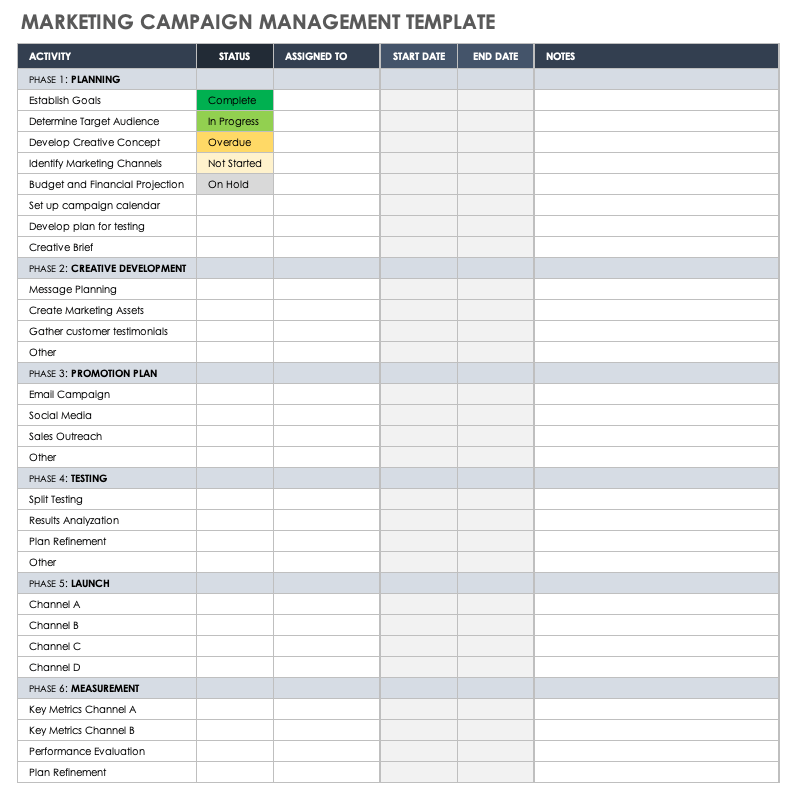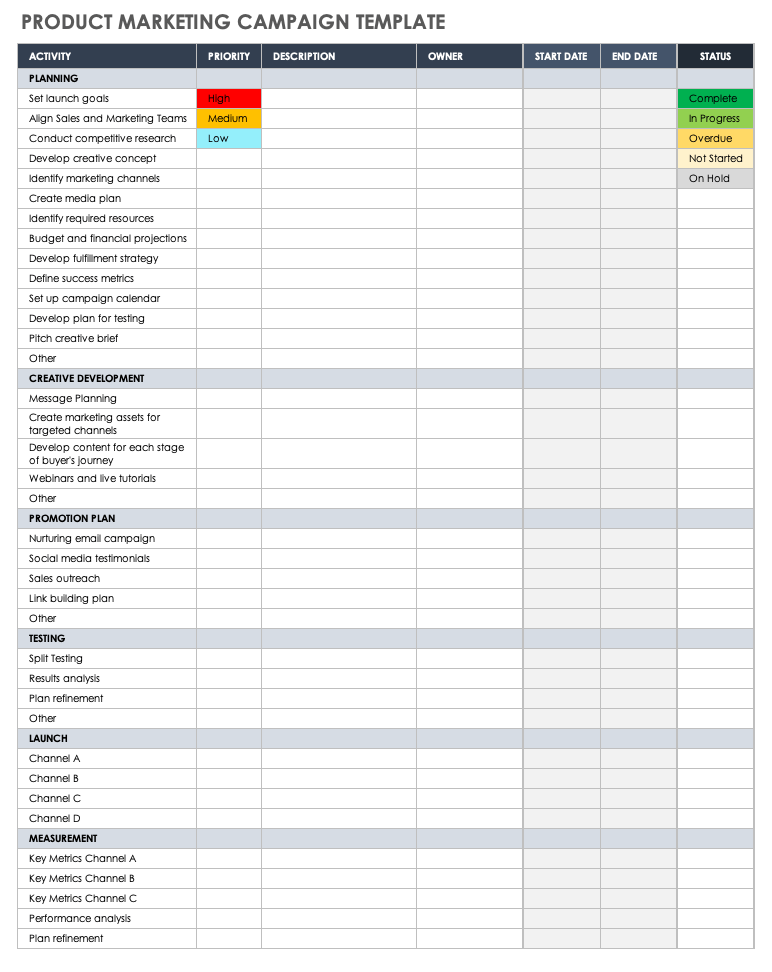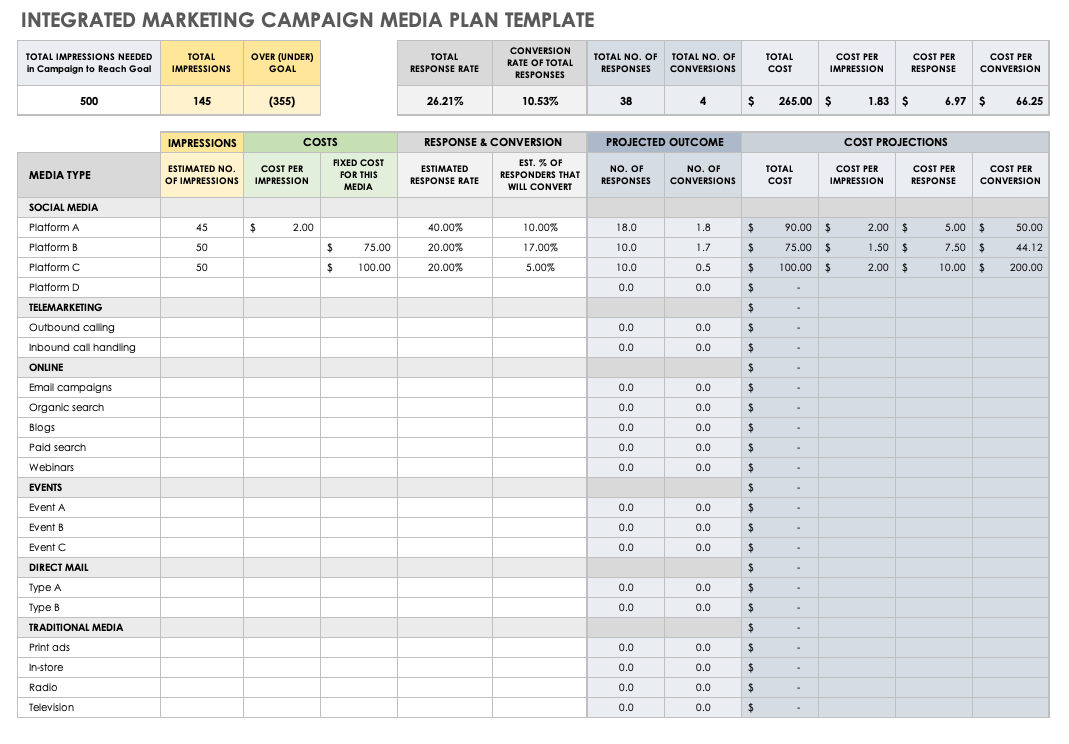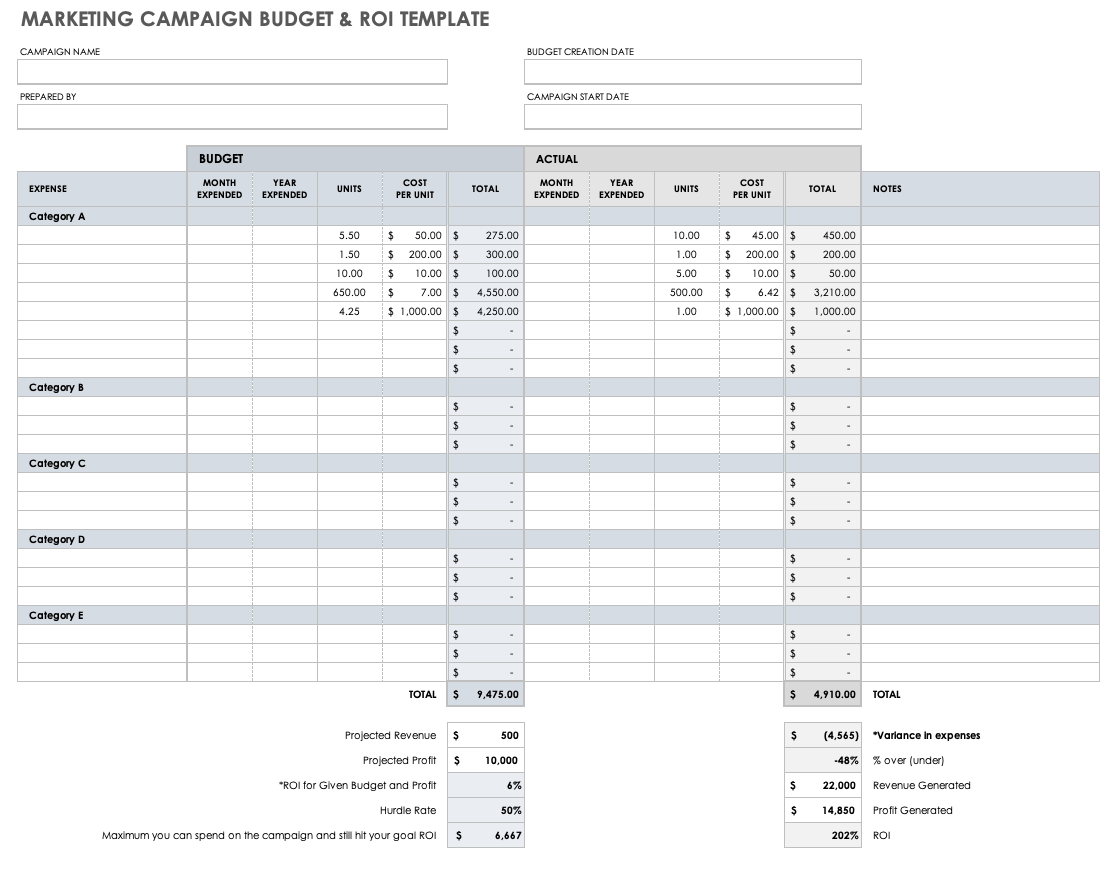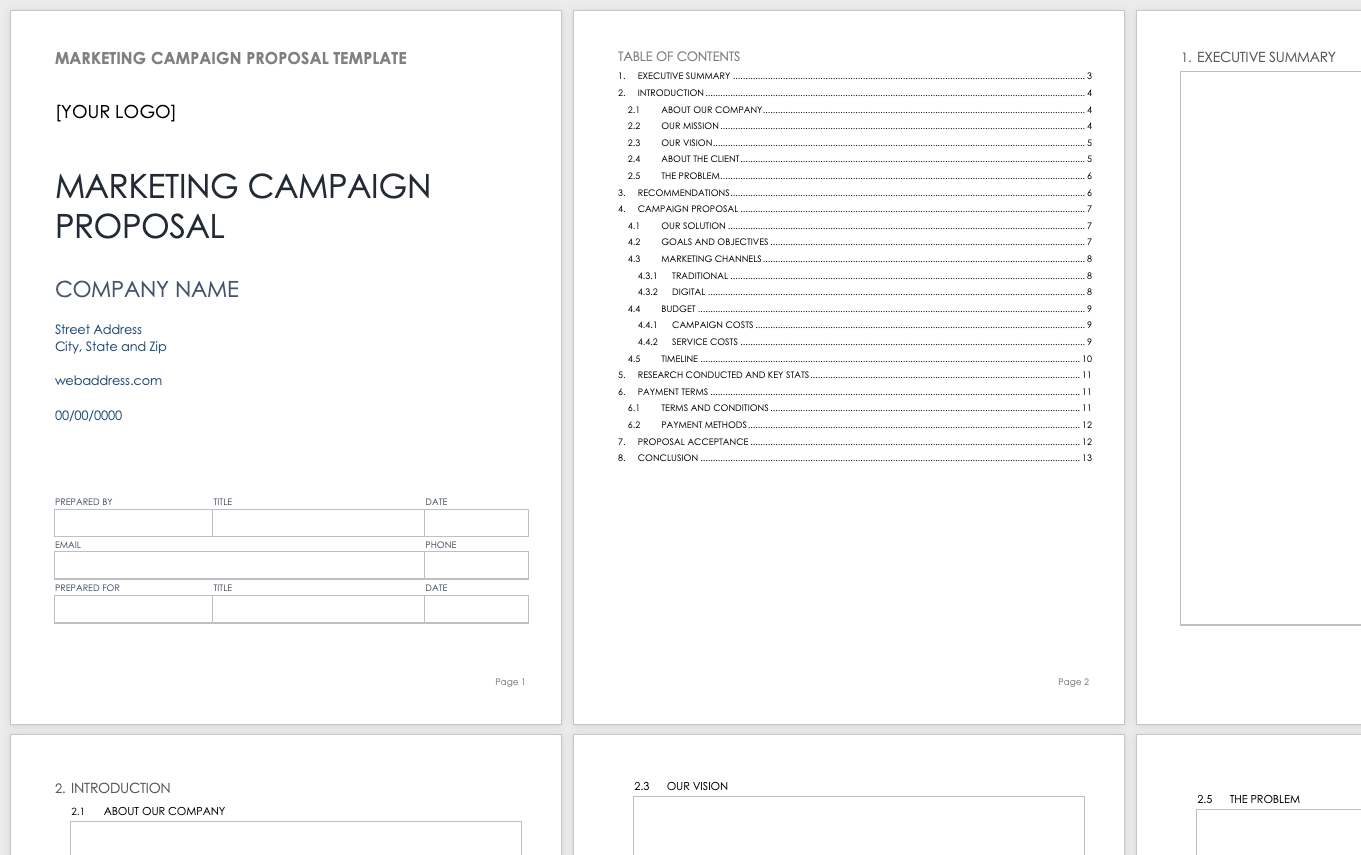Marketing Campaign Management Plan Template
This marketing campaign management plan template helps you organize and manage each phase of the campaign process, from planning to execution. Use this template to outline each component of the process, including the development of campaign goals, creative concept, calendar, messaging, promotion plan, testing, launch, and more.
Download Marketing Campaign Management Plan Template
Marketing Campaign Brief Template
Use this pre-built marketing campaign brief template to provide a detailed summary of your marketing campaign. This template has space to define the campaign’s purpose, objective, target audience, resources, budget, marketing channels, goals, key takeaway, and more in order to supply clear expectations and direction before the launch of a marketing campaign.
Download Marketing Campaign Brief Template
Word | PDF | Smartsheet
Product Marketing Campaign Template
This pre-built product marketing campaign template is customizable and is designed for both established businesses and startups. This template guides you through each step of the campaign process, including planning, creative content and asset development, promotional planning, testing, launch, and performance measurement.
Download Product Marketing Campaign Template
Integrated Marketing Campaign Media Plan Template
This campaign media plan template enables you to outline your campaign media types and your estimated number of impressions, costs, and response and conversion rates. Once you enter all values, the projected number of total responses, conversions, and costs will automatically calculate with built-in formulas. At the top of the template, enter the total number of impressions your campaign needs to generate in order to reach the campaign goal. Then, organize your media by category and input your projected values to calculate the total response and conversion rates.
Download Integrated Marketing Campaign Media Plan Template - Excel
Marketing Campaign Budget and ROI Template
Use this template to organize your marketing campaign budget and to project your initial return on investment (ROI). Under each category, input the name of the incurred expense, month expended, number of units, and cost per unit. Then, enter the projected revenue, profit, and hurdle rate. Once you enter all values, totals will automatically calculate with built-in formulas, including the expenses, expense variance, ROI, and maximum amount you can spend in order to still hit your ROI goal. This template also allows you to compare budgeted expenses to actual expenses, and includes space to add important notes.
Marketing Campaign Proposal Template
Use this pre-built template to structure and build out a professional marketing campaign proposal. This template has space to provide an executive summary, an introduction to your company, client information, campaign goals, a timeline, costs, payment terms, and more in order to effectively communicate your proposed solution to the client.
Download Marketing Campaign Proposal Template
Marketing Campaign Report Template
This marketing campaign report template enables you to report on key metrics of your campaign, including total reach, website visits, leads generated by source, customers generated by marketing efforts, conversion rates, and more. Use this template to track and analyze your campaign’s performance by marketing channel to see where you are making the most impact.
How to Create a Marketing Campaign Plan
In this section, we will provide a step-by-step guide to the process of building out a marketing campaign plan. Since a campaign plan is just one aspect of the marketing plan and focuses on a specific goal, it is essential to have your marketing plan in place before you begin.
Visit “Free Marketing Plan Templates, Examples, and a Comprehensive Guide” to get started developing your marketing plan.
Step 1: Establish Marketing Campaign Goals That Align with Your Business Goal
When you begin with the end in mind, you create a destination from which you can build out your campaign roadmap.
Here are some examples of common business goals to get you started:
- Build brand awareness.
- Improve customer service.
- Retain customers.
- Expand into a new market.
- Increase efficiency.
- Launch a new product.
- Increase sales.
During this step, it is critical to ensure that your marketing campaign goals align with and support your overarching business goal. For example, if your business goal is to expand into a new market, then your marketing campaign should target new customers.
Here are some examples of common campaign goals:
- Increase traffic.
- Generate leads.
- Increase social followers.
- Nurture existing leads.
- Target new customers.
- Build brand loyalty.
- Sell more of a specific product.
Visit our page with expert-tested goal-setting and goal-tracking templates to start creating clear and strategic campaign goals.
Step 2: Pinpoint Your Target Audience
Once your team rallies around a common goal, the next step is to determine your target audience. If we use the previous example, where the business goal is to expand into a new market and the campaign goal is to target new customers, then the next course of action is to identify and understand the group of buyers you aim to reach with your marketing message.
You can begin to define your target buyer by asking the following questions:
- What specific action do we want the buyer to take?
- What pain points does the buyer have that we can speak to in order to motivate them to take the desired action?
- How does the product or service solve the challenges, frustrations, and problems that the target buyer experiences?
- What characteristics that the target buyer possesses are most likely to move them to take the desired action? (For example, demographic or psychographic information may be the motivating factor.)
- Is there an alternative product or service that the target buyer currently uses to solve their problem?
- What types of media does the target buyer use (e.g., social networks, websites, magazines), and when are they most likely to use each type?
- What drives the target audience to make purchasing decisions?
Because it isn’t efficient or practical to target every individual consumer, focus your marketing efforts on a niche market that is most likely to buy your product or service.
Here are some steps you can take to help answer the questions above and uncover your target market:
- Gather data on your current customer base using analytics, surveys, focus groups, and customer segmentation analysis.
- Compile data on the competitive landscape.
- Research industry trends and customer buying patterns.
- Conduct tests and compare the results with your assumptions.
- Clearly define your unique value proposition (UVP), or unique selling proposition (USP).
Once you pinpoint your target audience, build a fictional visual representation of your ideal customer. You can gain insight into this process by reading “Easy Steps to Create a Buyer Persona Using Free Customer Profile Templates.”
Step 3: Develop a Creative Concept, or a “Big Idea”
Once you conduct research and identify your target audience, hold a brainstorming session with your team to determine the overarching theme or message that will resonate with your target buyer and emotionally connect them to your product or brand.
Here are some things to keep in mind when developing your theme:
- The creative concept should align with and support the established business and campaign goals.
- The creative theme should be consistent across all media channels and tie the whole campaign together.
- The message should be memorable and shareable, and should speak directly to the pain points and values of the target buyer.
- The message should capture the attention and interest of the target buyer and should communicate a clear call to action (CTA) to motivate them to take the desired next steps.
As you brainstorm ideas, consider what successful campaigns have worked in the past for you and your competitors.
Learn about and implement the best brainstorming approaches for generating ideas to get your team started.
Step 4: Identify the Most Effective Channels to Use to Achieve Your Goals
In order to effectively get your message in front of your target buyer, you must analyze which places they frequent (online and offline) and when they frequent them. The next step is to research both traditional and digital marketing media to figure out which tactics will bring the most value.
Below are some examples of commonly used channels:
- Digital Marketing Channels:
- Social media (Facebook, Twitter, Pinterest)
- Website (blog post, dedicated landing page)
- SEO/SEM (organic, PPC)
- Email (newsletter, automated workflow)
- Webinar
- Video (YouTube, website, streaming service)
- Traditional Marketing Channels:
- Event (PR, trade show, conference)
- Print ad (magazine, newspaper)
- In-store (signage, demo)
- Outdoor (billboard, brochure)
- Press release
- Direct sales
- TV
- Radio
- Catalog
- Direct mail
Some businesses choose a single-channel strategy to reach prospective buyers, while others choose a multichannel approach.
In addition to selecting the appropriate channel, it is crucial to develop a plan for the reach and frequency of your campaign that will generate the most value. In promotional planning, reach refers to the number of people you get your message in front of; frequency represents the number of times you get your message in front of them. Because resources are finite, the objective is to determine the following: whether to place your message in front of a large percentage of your target market a small number of times, or whether to reach a small percentage of your target market repeatedly over a period of time.
The goals of the business campaign and the marketing campaign, along with the preferences of the target buyer, determine the details of the following two actions: the specific channels to which you’ll allocate your time and resources, and the reach and frequency of your campaign. The successful implementation of these two actions, in turn, makes the biggest impact.
Step 5: Base Your Campaign Media Plan on the Channels You Select
This step takes the creative concept, or overarching campaign theme, and couples it with the marketing channel strategy to formulate a plan for media and messaging. The media plan should outline how various media activities will integrate and support one another to achieve the campaign’s objectives.
Consider the following factors in order to determine which media activities to invest in:
- Business and campaign goals
- Target audience preferences and behaviors
- Media trends
- Reach and frequency
- Budget
Analyze the data you’ve compiled in the previous steps to develop a strategy for content and asset development. This strategy should reach the target buyer in the preferred channels at the right time. It should also resonate with them and motivate them to take the desired action.
Step 6: Identify the Necessary Resources
In this step, list the talent and the creative assets you need to drive your campaign. Keep in mind whether you’ll need to outsource content to an agency or be able to create the assets in house.
Here are common examples of the resources marketers need to carry out a campaign plan:
- Content writers
- Graphic designers
- Project managers
- Event planners
- Creative assets (videos, images, and other media)
- Asset management system
- Project management tools
Once you identify the resources you require, develop a rough timeline of when the deliverables are due and the sequence in which the deliverables will roll out for the campaign.
List required assets and create an estimated timeline using one of our free timeline templates.
Step 7: Create Your Campaign Budget
Once you identify the campaign resources you need, assign dollar amounts to each category (e.g., marketing channels, creative asset development, hired talent) to ensure the plan is realistic and within the confines of your budget.
Take the following steps to build out your budget plan:
- Determine the total amount available to spend on the campaign.
- Allocate a percentage of the budget to your selected marketing channels (e.g., direct mail, digital marketing, events).
- Allocate a percentage of the budget to your required resources (e.g., creative assets, content developers, project managers, tools).
- Take the list of marketing channels and required resources and assign a maximum amount to each line item based on the percentage you’ve allocated to that item’s category.
Once you complete these steps, conduct research and gather estimates for each item to compare the estimated amounts to the maximum amounts allocated in the budget. For example, let’s say that you’ve allocated 30 percent of your campaign budget to marketing channels and that the maximum amount you’ve assigned to a specific marketing channel is $1,000. After conducting research, you discover that in order to meet your goal, you will need closer to $1,500 for that specific marketing channel. In this situation, you will need to reassess the campaign priorities and timeline and adjust the budget plan accordingly. In some cases, this adjustment will mean placing lower priority and lower value initiatives on hold, so you can direct resources to higher priority and higher value marketing activities.
A successful marketing campaign budget should balance the needs of target buyers with the goals of the business.
Create initial cost estimates for your campaign by checking out our free estimate templates, and plan out your budget by downloading one of our free marketing budget templates.
Step 8: Develop Your Campaign Fulfillment Strategy
In this step, create a strategy and outline the necessary procedures to match the goals of your campaign with your actual end user results in an efficient and timely manner.
Here are some examples of marketing campaign fulfillment requests:
- Provide a demo.
- Send an e-book.
- Provide a file download.
- Ship a product.
- Provide an online course.
- Deliver a piece of direct mail.
A sound campaign fulfillment strategy can help ensure you don’t over-promise and under-deliver to the end user.
Begin outlining your fulfillment plan by looking at the call to action in each of your marketing channels and examining the various ways in which potential customers will respond to your campaign. Will prospects respond to your offer with an inbound phone call? Will they fill out a form and submit it? Will they take action on your social media page? Your plan should provide details on the actions that prospects will take. It should also define the corresponding fulfillment strategy for those actions — including next steps and who is responsible.
As you develop your fulfillment plan, remember how vital it is to satisfy requests in a timely manner. You don’t want prospects to lose interest or forget about your offer. For example, if a prospect fills out a form to request a free demo, follow up promptly, while your brand is still top of mind.
Step 9: Define Marketing Campaign Success Metrics
How well your campaign performs directly affects your bottom line. So, make sure to select and track the appropriate metrics to gauge the performance of your campaign and make decisions accordingly.
To begin, reference the business and campaign goals you established in step 1 (e.g., build brand awareness, target new customers, increase leads). Then, determine the key performance indicators (KPIs) for each marketing channel that have a direct correlation with the main goals. For example, if the goal is to build brand awareness, then the key metrics to measure on social channels might include impressions, likes, shares, follows, and mentions.
You also need to consider the specific phase of a prospect’s journey when deciding which metrics to track.
The image below shows how the stage of a customer’s journey within a given channel determines which content to create and which performance metrics to evaluate:
To get a baseline, analyze how current marketing efforts are performing. Then, estimate how your marketing campaign will affect your success metrics, both in each channel and overall.
Marketers also look at the following metrics to gauge a campaign’s overall performance:
- Qualified leads (marketing and sales)
- Customers acquired
- Customer acquisition cost
- Net promoter score (NPS)
- Conversion rate
- Total revenue
- Return on investment
The KPIs you track should support your business and campaign goals and should provide direction for your content creation efforts.
Measure your marketing campaign’s success metrics by downloading any of our free dashboard templates, including a lead generation dashboard template, marketing dashboard template, and social media dashboard template.
Step 10: Set Up Your Campaign Calendar
Map out each phase of your campaign — from planning to execution — to identify and measure campaign marketing efforts and associated costs during a specific time frame.
Below are the key elements to include in a campaign calendar:
- Tasks: List the marketing activities and include brief descriptions of each task.
- Task Ownership: Assign roles for each task and subtask, including tasks that will be completed by contractors, consultants, and designers.
- Milestones: Set campaign milestones to guide marketing efforts and track campaign progress each step of the way.
- Key Dates: Enter start and end dates for each phase, milestone, and task to establish a timeline.
- Dependencies: Identify tasks that rely on the completion or initiation of another task.
- Budget: Reference the budget you created in Step 7 to allocate costs to each activity.
Save time and create your campaign calendar using one of our free marketing calendar templates, available in Google, Excel, and Word formats.
Step 11: Pitch Your Marketing Campaign to Stakeholders
Once you establish your goals, identify necessary resources, develop your plan, and assign roles for each marketing activity, you’re equipped to prepare and pitch a campaign brief to internal and external stakeholders.
The following tips will help ensure you present a successful campaign pitch:
- Be informational without being “salesy.”
- State the goals and objectives of the campaign and how you plan to measure the performance against the objectives.
- Provide the details of your creative proposal and the resources you’ll need to carry out your plan.
- Describe the target audience and explain why buyers will care about your marketing campaign.
- Present your findings on market research, including what top competitors are doing and which industry trends support your strategy.
- Back up your strategies with research you can demonstrate visually (graphs, charts, etc.).
- Outline the risks associated with your campaign and what you plan to do to mitigate them.
- Discuss the proposed budget for the resources you need to carry out the campaign, including creative talent, project management, time, and tools.
- Provide an estimated timeline of the campaign schedule, including key dates and milestones.
- Present success metrics and projections for your campaign, with an emphasis on the return on investment.
Prepare for an effective pitch by downloading any of our free creative brief templates that you can customize to fit your needs.
Step 12: Put Your Plan into Action and Measure Results
By this step, all the prep work is complete and you’re ready to launch your campaign plan.
Consider the following tips to ensure your launch is successful:
- Schedule a pre-launch marketing brief with the team to go over the plan and calendar and clarify expectations and responsibilities.
- Roll out your campaign plan in increments and perform A/B tests on small subsets of your target market to see how buyers respond.
- Reference your campaign calendar to track progress, compare actual costs to your budget, and measure performance.
- Compare campaign results with initial projections. Then, adjust your plan accordingly.
Manage and track each phase and project associated with the campaign by downloading any of our free project report templates, including a postmortem report to reflect on lessons learned and key takeaways.
The Top 5 Tips for Implementing for a Successful Campaign
Successful campaigns don’t happen by accident. In fact, impactful campaigns take time and intentional planning.
Below, you’ll find the top five things that successful campaigns have in common. You can implement these strategies during the planning of your next campaign.
- Begin with the End in Mind: Have clear goals in place to provide direction for your team’s marketing efforts. Once you know what it is you’re trying to achieve, the planning process becomes more efficient and team members work with a sense of purpose. Learn more from these marketing campaign examples.
- Build Trust First. Then, Sell: Build rapport with prospects to make your brand personable and memorable. Making a connection is the first step toward building a relationship, which then leads to loyalty and brand evangelism. A good product may get people in the door, but trust and a pleasant brand experience will keep them in the room.
- Be in the Right Place at the Right Time: The better you understand your target audience, the more capable you are of delivering the right content to them at the right time. Knowing what stage of the buyer’s journey a prospect is in means you can meet them when they are most likely to consume and engage with your content.
- Be Agile: Being up to date concerning ever-changing social and technological trends means knowing about current user behavior and happenings in your industry. Successful brands must be able to adapt and react in a timely manner in order to remain competitive and improve.
- Use Proper Campaign Management Tools: Since an effective management strategy lies at the core of a winning campaign, ensure you have the proper tools in place to plan, delegate, execute, and report on all aspects of your marketing campaign efficiently.
Improve Your Marketing Campaigns with Smartsheet for Marketing
The best marketing teams know the importance of effective campaign management, consistent creative operations, and powerful event logistics -- and Smartsheet helps you deliver on all three so you can be more effective and achieve more.
The Smartsheet platform makes it easy to plan, capture, manage, and report on work from anywhere, helping your team be more effective and get more done. Report on key metrics and get real-time visibility into work as it happens with roll-up reports, dashboards, and automated workflows built to keep your team connected and informed.
When teams have clarity into the work getting done, there’s no telling how much more they can accomplish in the same amount of time. Try Smartsheet for free, today.
